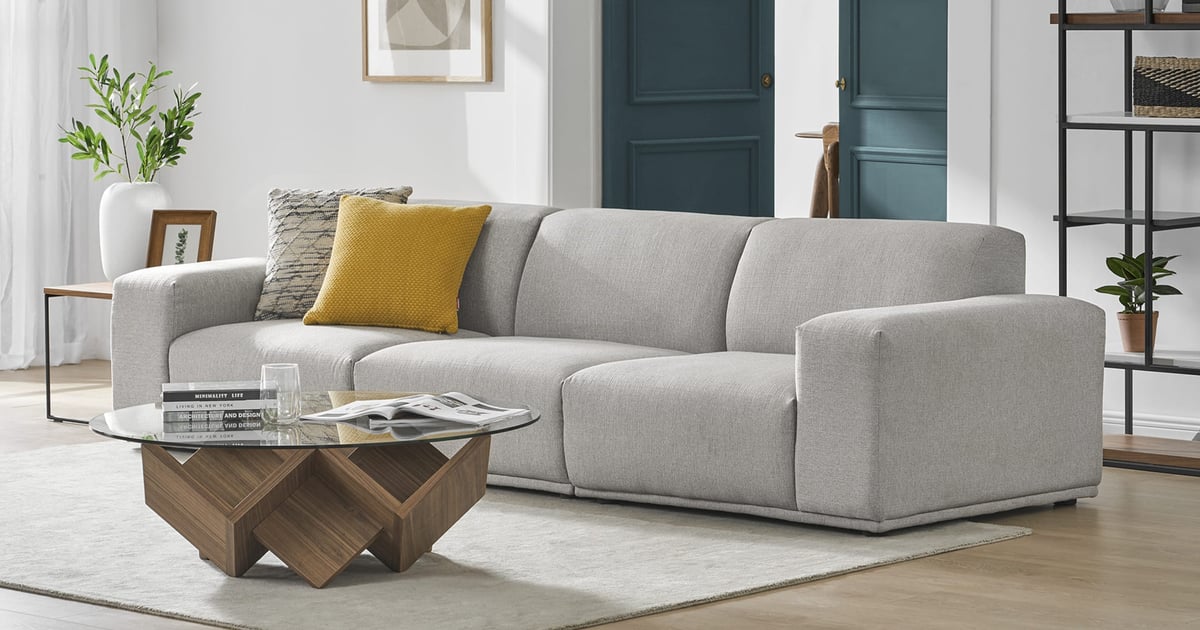A sofa is a large, heavy piece of furniture that is often the main focal point and gathering place in a living space. But how much does the average sofa weigh? The weight of a sofa can vary greatly based on size, interior construction and frame materials, upholstery fabrics, additional features such as reclines and mattresses, and overall style. Understanding the different factors that affect the weight of your sofa will help you plan key considerations appropriately.

Typical Weight Ranges for Standard Couches and Sofas
Most standard full-size couches and sofas without extra built-in features like power recliners and sleeper mattresses fall within these general weight ranges:
- Loveseat: 70-100 lbs
- Standard Sofa: 100-200 lbs
- Sectional Sofa: 150-400 lbs depending on number of sections
The inclusion of power reclining mechanisms, sleeper mattresses, storage compartments, and other functional features can tack on an additional 50-100 lbs or more to those base weights.

Key Factors that Influence the Weight of a Couch
While couch models of similar sizes and styles may look comparable at first glance, their actual weights can vary substantially because of differences in internal construction and materials. Several variables significantly impact the final weight of a particular couch model.
Frame Material Used in Couch Construction
The internal wooden frame provides the foundational structure of a couch that supports the cushions, fabrics, and users. Couches made with heavier hardwood frames like oak generally weigh more than those with softwood frames like pine. And wood frames are heavier than metal frames found on some contemporary couches.
Upholstery Materials and Fabrics
For the upholstery, leather coverings add significant weight compared to most standard woven fabric coverings. Deeply padded or tufted upholstery also weighs more than smoothly upholstered styles. Thicker, high-grade upholstery weighs more than cheap lightweight fabrics as well.
Cushion Fill Material Type
The fill materials used inside the seat, backrest, and other cushions impacts weight. Foam cushions are generally much lighter than fiber or down-filled cushions. Cushions stuffed with high-density foam weigh less than those filled with feathers or down. And down-alternative poly-fill is lighter than real goose down or duck feathers.
Overall Couch Size and Shape
Larger couches like oversized sectionals naturally weigh substantially more than smaller standard sofas or loveseats. The overall structure spans a wider area and uses more frame, upholstery, and fill materials. Unique L-shaped sectionals weigh more than standard rectangular sofas.
Inclusion of Hardware, Features and Functions
The addition of power reclining systems, storage compartments, sleeper sofa mattresses, and other specialty features adds mechanical components and additional materials that pile on pounds. Integrated features make the couch body inherently heavier.

Benefits and Advantages of a Heavier Weight Couch
While heavy couches can be more difficult to handle, the additional weight provides some nice benefits in terms of functionality and feel:
- Stays Firmly Planted in Position – A heavyweight couch is less prone to shifting, sliding, or tipping over from heavy use or pressure. The added mass creates stability.
- Feels More Study and Well-Built – More substantial weight makes a couch seem sturdier and higher quality to those sitting on it. Light couches may feel flimsy.
- Doesn’t Tip Over When Leaned On – With greater mass, there’s less risk of a heavy couch toppling over if people sit on the armrests or backrest. Kids can play more roughly.
- Provides Needed Anchor for Recliners and Sleepers – For power reclining mechanisms and sleeper mattresses to function properly without lifting up, the couch base needs sufficient weight.
- Resists Impact Force Better – The momentum of rambunctious kids or pets crashing down onto cushions is absorbed better by heavier couches. They dent less from collisions.
In these aspects, higher couch weight offers tangible benefits for family homes subject to demanding use over many years.
Tips for Transporting and Installing Overly Heavy Couches
If you’ve selected an exceptionally weighty couch model exceeding 200-400 lbs, special preparations must be made to safely transport it to your home and get it situated inside without damage or injury:
- Remove Doors – Detach hinged doors if possible and utilize moving straps to gradually pivot and slide the couch through openings. This avoids lifting or tilting which could crack fragile frames.
- Rent Appliance Dolly or Climber Straps – For stairs, rent a special appliance dolly designed for heavy objects, or nylon stair climbing straps that allow couches to be tilted back and slowly maneuvered up or down steps.
- Hire Professional Furniture Movers – Those experienced with maneuvering ultra heavy couches use specialized lifting equipment, straps, dollies and moving techniques to ensure a smooth transition without harming floors or the furnishings.
- Check Floor Weight Limits – Before final positioning extra heavy couches, verify floor pressure limits are not exceeded to avoid gradually sinking or sudden plank cracks under excessive stationary weights.
Doing a bit of planning and prep work to accommodate the realities of large overweight couches eliminates surprises and ensures everyone’s safety along with protecting your home. Know the approximate couch weight ahead of time before finalizing a purchase.
